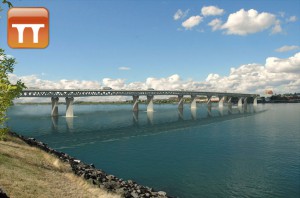Two state representatives, Andy Olson of Albany and Sara Gelser of Corvallis, have found answers to my questions about tolling on the proposed new interstate bridge in Portland, the $2.8 billion Columbia River Crossing. No, there will be no toll booths if the bridge is built. Instead, here is how it would work:
Olson has learned, motorists will have three ways to pay the toll, now estimated at $2.50 but possibly higher during rush hour. They can use a transponder that causes the bridge to record their crossings; they can buy a pass for one or several days at a store, or they can be billed through the mail based on their license plates being read as they cross.
Gelser came across a consultant’s estimate that tolls would be collected from 86 percent of “customers” at first, rising to 90 percent in time. In other words, they figure that one in 10 will cross the bridge without ever paying the toll. They expect that 64 percent of the bridge users will prepay their tolls and 22 percent will have to be billed, with 7 to 9 percent requiring “enforcement proceedings.”
What enforcement? They could be charged with “theft of services” under an existing law. This would be a misdemeanor until the amount of evaded tolls hits $1,000; then it becomes a felony. Or the state could hold up renewal of vehicle registrations, place a lien on property or garnish wages. Eighteen other states use one or several of these methods to collect tolls.
Washington residents are expected to make up about two-thirds of the bridge users, Oregonians about one-third, and motorists from elsewhere about 1 percent. Now it’s obvious to me why officials were so concerned about the question of whether Oregon can enforce its toll-collection methods in Washington state.
It sure seems that billing people for $2.50 through the mail is kind of cumbersome, especially because it adds one more element — plate-reading cameras — to our surveillance society. Would not toll booths be more benign? (hh)



This sounds similar to how tolls are handled for the Golden Gate Bridge, including the cameras and mailing of toll fees to registered car owners.
As I recall, Washington did not want to pony up money for this bridge last year, even though Oregon and the Federal government did. If that is still the case, and Oregon taxpayers foot a portion of the bill, then it would seem fair that cars registered in Oregon should pay less in fees than cars registered in Washington (or any other state for that matter). If that is not the case, then we would effectively be paying for the bridge twice.